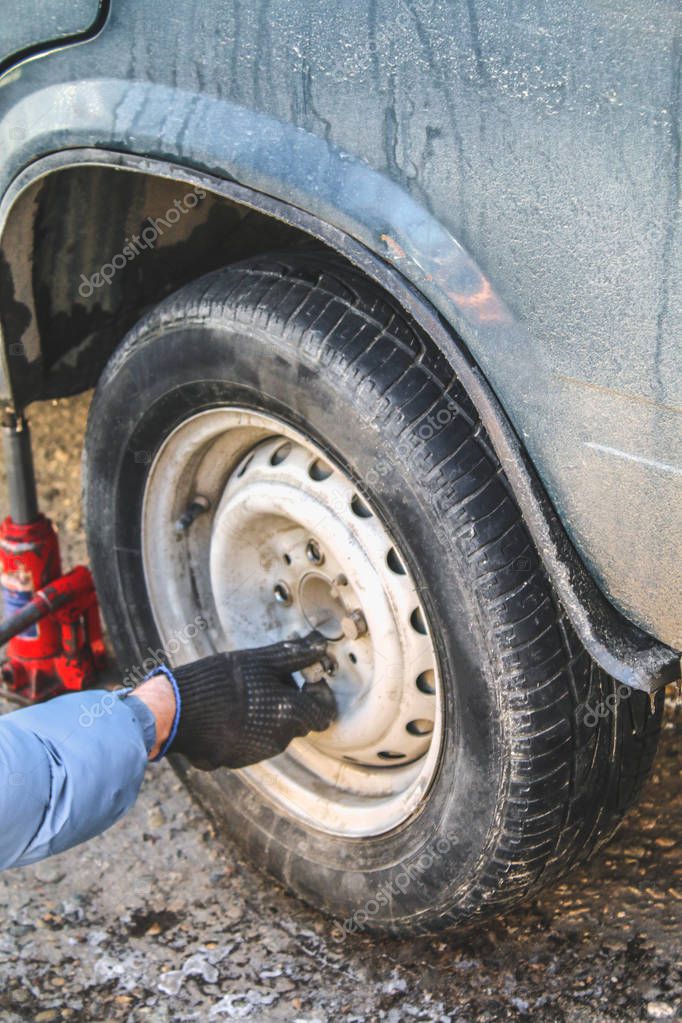By: Deanna Sclar and
Updated: 12-01-2021
From The Book: Auto Repair For Dummies, 2nd Edition
Explore Book Buy On Amazon
Having a flat tire and not knowing how to change it can leave you feeling helpless. With a few simple tools, you can do it yourself. Changing a tire is easy, and everyone should have a general idea of what's involved. Here are the steps:
Never change a tire on an incline or hill; always seek a flat surface, even if it means driving on a flat tire. Use bricks, wooden wedges, or metal wheel chocks to block the wheels at the opposite end of the car from the end that is to be raised.
You can use a screwdriver to pry the wheel cover off. Just insert the point of the tool where the edge of the cover meets the wheel, and apply a little leverage. The cap should pop off. You may have to do this in a couple of places, as if you were prying the lid off a can of paint.
You might know this as breaking the lug nuts. Whatever you call it, find the end of the wrench that fits the lug nuts on your vehicle, and fit it onto the first nut. Apply all your weight to the bar on the left. This starts turning the nut counterclockwise, which loosens it. Don‘t remove the lug nuts completely; just get them loose enough to remove by hand after you jack up the vehicle. A hollow pipe and a cross-shaft wrench can loosen the tightest lug nuts.
If you have alloy wheels that are held on by lug nuts with delicate finishes, the delicate aluminum or chrome-plated lug nuts need careful handling.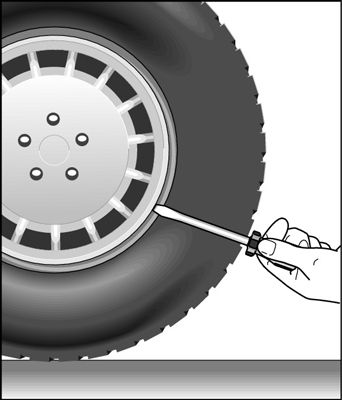 They should never be loosened or replaced with power tools that can scratch the delicate finish.
They should never be loosened or replaced with power tools that can scratch the delicate finish.
Place the jack securely under the edge of the car. Proper locations may vary among vehicle models, so consult the owner’s manual for the right places to put the jack.
If you have a scissor jack (see image a), insert the rod or wrench over the knob, and then crank. If you have a hydraulic jack (see image b), place the handle into the appropriate location and pump up and down. Use nice, even strokes, taking the jack handle from its lowest point to its highest point on each stroke to cut down on the labor involved.
Take the lug nuts completely off by hand and put them in a safe place — inside the wheel cover or hub cap works well. Grasp the flat tire with both hands and pull it straight toward you.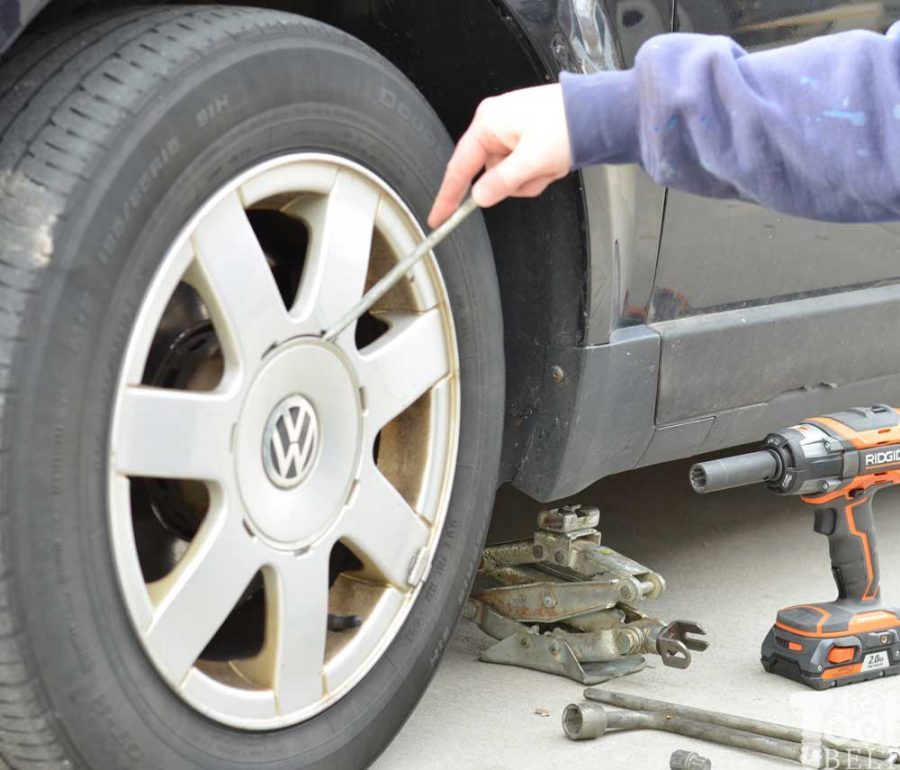 As you pull the flat off, it should slide along the bolts until it clears the end of the bolts and you find yourself supporting its full weight. Roll the flat along the ground to the rear of the vehicle to get it out of the way.
As you pull the flat off, it should slide along the bolts until it clears the end of the bolts and you find yourself supporting its full weight. Roll the flat along the ground to the rear of the vehicle to get it out of the way.
Because tires are heavy, you may have a little trouble lifting the spare into place — especially if you’re not accustomed to lifting heavy things.
Give each lug nut a jolt with the wrench to get it firmly into place, but wait until the car is on the ground before you really try to tighten the lug nuts.
After the vehicle is resting on the ground, use the lug wrench to tighten the lug nuts as much as you can.

If your car has wheel covers with a delicate finish, the owner’s manual should provide instructions for replacing it. If your car has hubcaps, place the hubcap against the wheel and whack it into place with the heel of your hand. Cushion your hand with a soft rag first so that you won’t hurt it. And don’t hit the hubcap with a wrench or hammer — you’ll dent it.
Deanna Sclar is an acclaimed auto repair expert. She has appeared on hundreds of radio and TV shows, including NBC's Today show and the NBCNightly News. Sclar lectures internationally on the ecological impact of vehicles and is active in promoting residential solar energy programs. Sclar is also the author of Buying a Car For Dummies.
Sclar is also the author of Buying a Car For Dummies.
Knowing how to change a tire is a necessary skill for all drivers. If you rely on a cell phone to save you in a roadside emergency, there’s always that chance you will forget to charge it, be out of range, or leave it at home. Flat tires can happen anywhere, and a cell phone is no substitute for knowing how to change a flat tire.
Thankfully, changing a tire isn’t all that hard! Just adhere to the following guidelines to be prepared in case you have a flat.
These items should have come with your vehicle:
Jack
Lug wrench
Fully inflated spare tire
Vehicle owner’s manual
If you have misplaced any of these items, or if your car did not come with these items, you should purchase new ones right away. And be sure you’re regularly inflating the spare tire to your vehicle manufacturer’s recommended PSI. You should check the spare’s air pressure every time you check your other tires. Remember to check pressure every month and before long trips or carrying extra load.
And be sure you’re regularly inflating the spare tire to your vehicle manufacturer’s recommended PSI. You should check the spare’s air pressure every time you check your other tires. Remember to check pressure every month and before long trips or carrying extra load.
Here are some items that don’t come with your vehicle but that you should stow in your trunk or glove box in case you have to change a flat tire:
Flashlight with working batteries
Rain poncho
Small cut of 2"x6” wood to secure the jack
Gloves
Wheel wedges
As soon as you realize you have a flat tire, do not abruptly brake or turn. Slowly reduce speed and scan your surroundings for a level, straight stretch of road with a wide shoulder. An empty parking lot would be an ideal place. Level ground is good because it will prevent your vehicle from rolling. Also, straight stretches of road are better than curves because oncoming traffic is more likely to see you.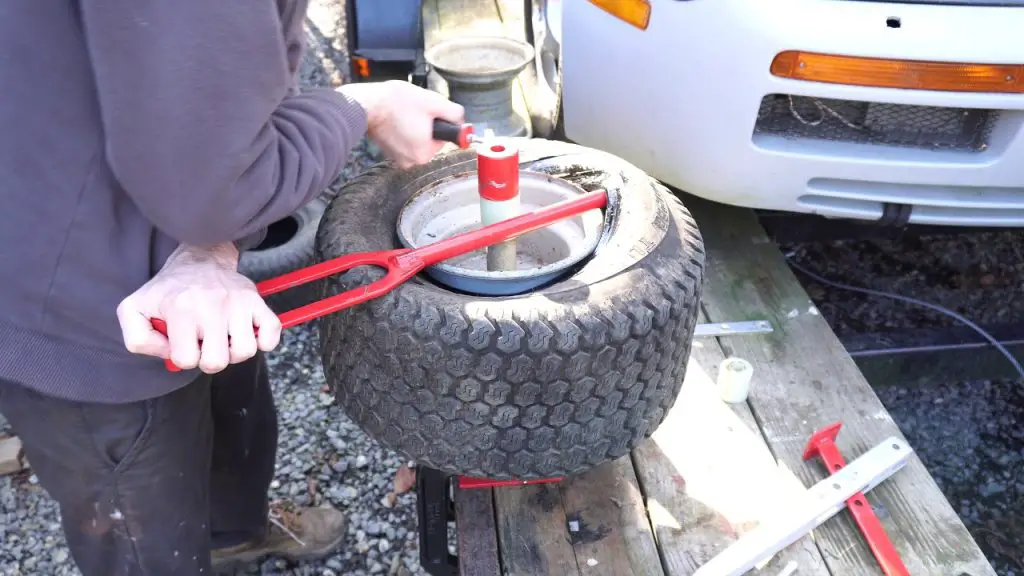
Never attempt to change your tire on a narrow shoulder near oncoming traffic. Keep moving (slowly) until you find a safer spot. While driving on a flat risks ruining your rim, replacing a rim is better than being hit by an inattentive driver.
Make sure to consult your owner’s manual and review their specific steps on how to change a flat tire for your vehicle
Your hazard lights or “flashers” will help other drivers see you on the side of the road. To avoid an accident, turn them on as soon as you realize you need to pull over.
Once stopped, always use the parking brake when preparing to replace a flat tire. This will minimize the possibility of your vehicle rolling.
Wheel wedges go in front of or behind the tires to further ensure the vehicle doesn’t roll while you fix the flat tire. If you’re changing a rear tire, place these in front of the front tires. If your flat tire is at the front, put the wheel wedges behind the rear tires.
If your flat tire is at the front, put the wheel wedges behind the rear tires.
Bricks or large stones will work just as well as “real” wheel wedges. Just be sure they’re large enough to stop the car from rolling.
If your vehicle has a hubcap covering the lug nuts, it’s easier to remove the hubcap before lifting the vehicle with the jack. If your lug nuts are exposed, you can skip ahead to Step 6.
Use the flat end of your lug wrench to remove the hubcap. This will work for most vehicles, but some hubcaps need a different tool to come off. Consult your owner’s manual for proper hubcap or wheel cover removal procedures.
Using the lug wrench, turn the lug nuts counterclockwise until you break their resistance. You may have to use force, and that’s ok. Use your foot or all of your body weight if necessary.
Loosen the lug nuts about ¼ to ½ of a turn, but don’t remove them completely yet. Save that for when it’s time to remove your tire/wheel from the vehicle.
The right place for the jack is usually beneath the vehicle frame alongside the tire that’s flat. Many vehicle frames have molded plastic on the bottom with a cleared area of exposed metal specifically for the jack. To safely lift and avoid damage to the vehicle, follow the instructions for jack placement in your vehicle owner’s manual.
To prevent the jack from settling under the weight of your vehicle and coming off balance, place a small cut of 2x6” wood beneath it before attempting to raise your vehicle. This tactic is especially helpful on asphalt.
With the jack properly positioned, raise the vehicle until the flat tire is about six inches above the ground.
Never put any part of your body under the vehicle during or after raising the vehicle with the jack.
Now it’s time to remove the lug nuts all the way. Since you've already loosened them, you should be able to unscrew them mostly by hand.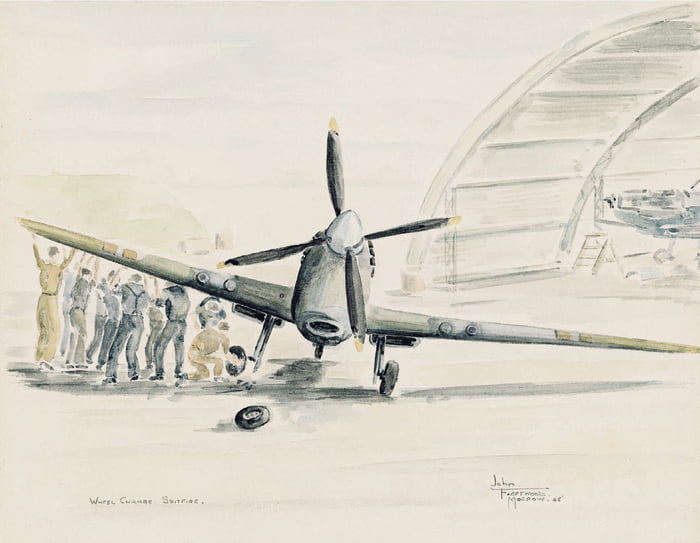
Gripping the tire by the treads, pull it gently toward you until it’s completely free from the hub behind it. Set it on its side so that it doesn’t roll away.
Now place the spare on the hub by lining up the rim with the lug bolts. Push gently until the lug bolts show through the rim.
Put the lug nuts back on the lug bolts and tighten them all the way by hand. Once they are all on, check each one again, tightening as much as possible. You will tighten them with the wrench after lowering the vehicle to the ground.
Use the jack to lower the vehicle so that the spare tire is resting on the ground but the full weight of the vehicle isn’t fully on the tire. At this point, you should tighten the lug nuts with the wrench, turning clockwise, as much as you can. Push down on the lug wrench with the full weight of your body.
Bring the vehicle all the way to the ground and remove the jack. Give the lug nuts another pull with the wrench to ensure they’re as tight as possible.
If the hubcap you took from the flat tire will fit your spare, put it in place the same way you removed it initially. If it doesn’t fit, stow it away with the tire when you stow your equipment.
You have before you a jack, a lug wrench, wheel wedges, your flat tire, and possibly a hubcap. Don’t forget to put all of them in your vehicle before driving away.
You should check the tire pressure of the spare tire to make sure that it is safe to drive on. “T-Type” temporary spares, also called “mini-spares,” require 60 psi (420 kPa). If the tire needs pressure, drive (slowly) to a service station immediately.
Temporary spare tires aren’t made to drive long distances or at high speeds, so drive cautiously until you’re able to visit a tire technician. A professional should be able to determine whether your tire needs a repair or if it’s time to replace it.
A professional should be able to determine whether your tire needs a repair or if it’s time to replace it.
Aside from taking your tire to a professional, the above procedure shouldn’t take more than 15 to 30 minutes to change a tire. Just be sure you don’t leave out any steps.
It’s beneficial practice changing a tire in your garage or driveway to ensure you’re ready to handle this situation if it ever happens to you.
Knowing how to fix a flat tire is great, but regular tire maintenance is even more important. In addition to reviewing this guide regularly, remember to do the following:
Keep your tires properly inflated
Rotate your tires according to the manufacturer’s guidelines
Monitor for tread wear
All of these precautions will extend the life of your tires and reduce the likelihood of a flat. While there’s no way to prevent flat tires completely, proper care can improve performance and ensure your tires last as long as possible.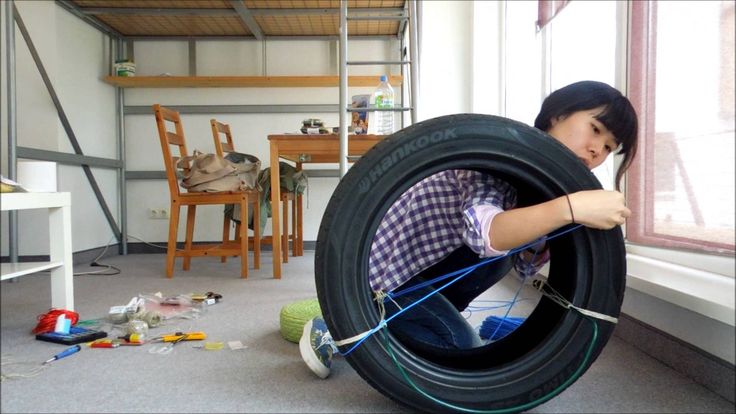
There’s never a good time for a flat. That’s why Bridgestone DriveGuard tires are masterfully engineered to keep you moving for up to 50 miles at speeds up to 50 MPH without disruption.
There’s never a good time for a flat. That’s why Bridgestone DriveGuard tires are masterfully engineered to keep you moving for up to 50 miles at speeds up to 50 MPH without disruption.
See Details Find Your Fit
Motorists often change rubber - either from summer to winter, then from winter to summer, then when buying new tires, then with damage and punctures. Tire replacement is usually entrusted to service stations. But, in order to save money or for other reasons, motorists can master this procedure on their own. To replace rubber with your own hands, you need a wheel wrench, a pair of mounting blades, a jack and a car pump. However, without knowing some “secrets”, it is difficult to replace a tire on your own. We'll talk about the tricks of replacing a tire now.
To replace rubber with your own hands, you need a wheel wrench, a pair of mounting blades, a jack and a car pump. However, without knowing some “secrets”, it is difficult to replace a tire on your own. We'll talk about the tricks of replacing a tire now.
First, remove the old tire from the rim. To do this, raise the car with a jack, unscrew the fixing bolts with a wheelbrace and remove the wheel from the car. Lay the wheel on the ground with the valve up, remove the nipple from the valve and let the air out of the tube or tire (if the tire is tubeless). After that, “drown” the valve inside the tire and stand with your feet on the wheel so that the sidewalls of the tire are wrung out from the rim. Sometimes the tire "sticks" to the rim and you have to make an effort. After you managed to wring out the sidewalls, insert the mounting spatula into the gap between the rim and the sidewall of the tire. Working with two mounting blades, bring the sidewall of the tire out of the wheel rim, and pull out the chamber into the resulting gap. In the same way, bring the other sidewall of the tire through the same rim, and remove it from the disk. Be careful not to damage the disc. Particular care must be taken with a fragile alloy wheel.
In the same way, bring the other sidewall of the tire through the same rim, and remove it from the disk. Be careful not to damage the disc. Particular care must be taken with a fragile alloy wheel.
Before installing a new tire on a rim, check its condition - carefully inspect it for defects and damage, make sure that the tire and rim fit each other in size. Also check the condition of the disk, for mechanical damage, the absence of dirt and rust, wear of the rim flanges. Remove the old balance weights and the old valve if the tire is tubeless.
When fitting new tyres, remember to take into account the color markings and indications on the tyre. Namely, the recommended direction of rotation, which is usually indicated by an arrow on the sidewall of the tire. For an easier and more gentle installation of the tire, you need to apply a special lubricant or soap solution to its bead and bead heel. Don't over-lubricate or the tire will slip on the rim!
Mounting the tire on the rim is carried out in the reverse order with respect to dismantling, that is, first one sidewall is put on the rim of the rim and, if it is a tire with a tube, then the tube is inserted, while its valve must enter the hole in the rim.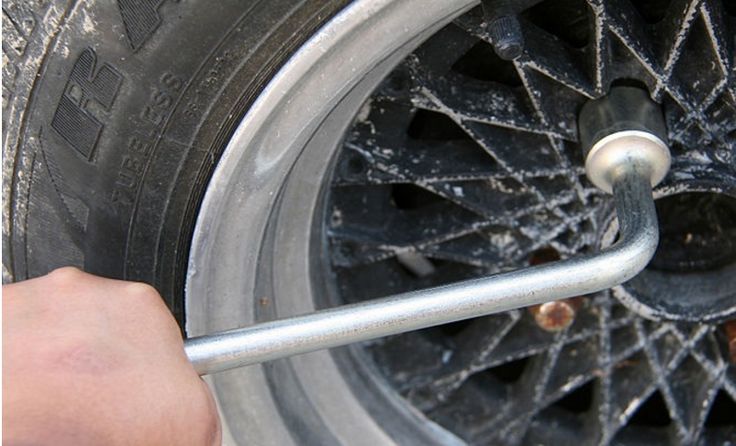 After that, the second sidewall of the tire is put on.
After that, the second sidewall of the tire is put on.
If the tire is tubeless, then the task is more complicated. Unfortunately, it will not be possible to inflate it with a conventional hand or foot pump or even a car compressor until the tire beads “sit” tightly on the rim, since the air will simply go out into the gap between the tire and the rim of the disk. But there is a way out!
To solve the problem, inflate any car wheel to 3.5 - 4 atm., remove the hose from the pump, put one end of this hose (the one without a fitting) directly on the valve of a freshly mounted tubeless tire, after removing the nipple from the valve , and put the other end of the hose, equipped with a fitting, on the “pumped” tire. At the moment of putting on the fitting, a large portion of air will enter the empty tubeless tire and "put it in place" on the disk. The beads of the tire will sit firmly on the rim, and the tire can now be inflated in the usual way. At service stations, special compressors with volumetric receivers are used to inflate tubeless tires, but, as you can see, you can solve this problem yourself, at home.
The beads of the tire will sit firmly on the rim, and the tire can now be inflated in the usual way. At service stations, special compressors with volumetric receivers are used to inflate tubeless tires, but, as you can see, you can solve this problem yourself, at home.
Do not forget that after installing a new tire, the wheel must be re-balanced.
For a car, winter does not begin on December 1, but at the moment when the air temperature drops below 7 degrees Celsius. At this point, tires made from a technical rubber compound for use in hot weather begin to tan. As a result, the stopping distance of the car increases dramatically (depending on weather conditions - from 40 to 200%). In addition, a car on summer tires skids in turns, slipping at the start is possible: it's time to change shoes.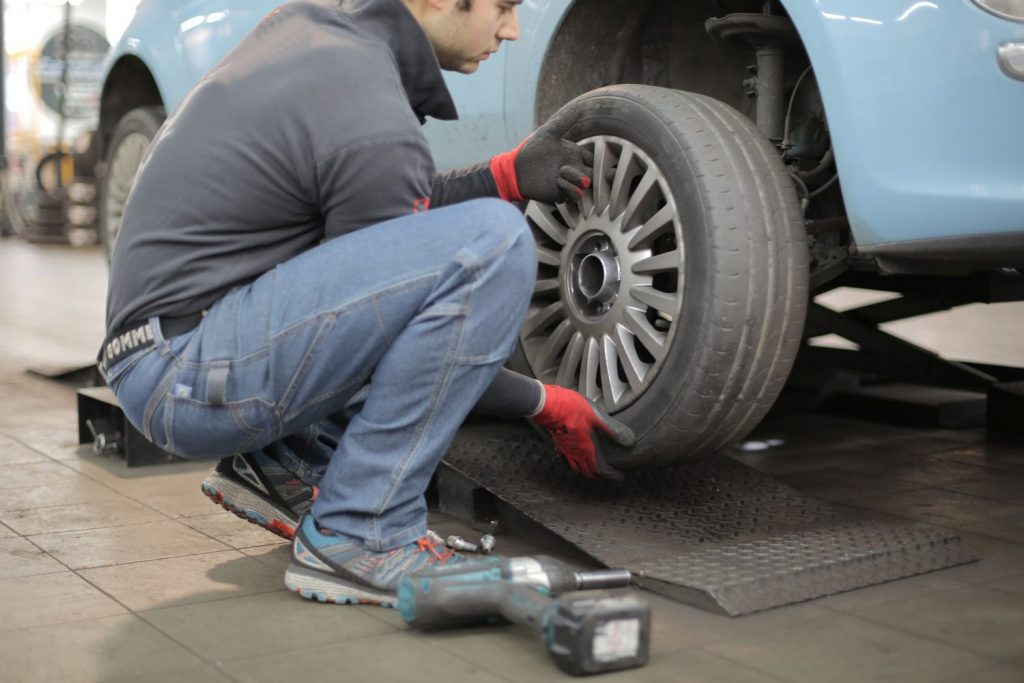 We learned how to avoid mistakes as a driver.
We learned how to avoid mistakes as a driver.
The consequences of driving on summer tires at temperatures below zero are eloquently illustrated by the mass accident that occurred on the first cold morning of October 19 this year. After a night frost, the road was covered with a thin crust of ice in the morning. Some of the drivers continued to drive "as usual": briskly maneuvering, trying to squeeze through the stream. However, the coefficient of adhesion of summer wheels to the road on such a surface decreased by 4 times - as a result, a collision of 9 (!) Cars occurred.
A chain accident began with the fact that the culprit of the accident skidded at low speed, and he flew into the oncoming lane. Fortunately, only iron was damaged. But if the same thing happened at a speed of even 60-70 km per hour, the consequences would be tragic.
It is conditionally possible to divide winter tires into two groups. Firstly, tires of the Central European type, focused on asphalt roads, which are regularly cleaned. Secondly, arctic tires (other names - Scandinavian, Nordic), created specifically for snowy and icy roads. The difference between them is the hardness of the material. So, arctic tires are soft (from 50 to 55 Shore hardness units - this parameter is stamped on the tread), which is only twice as hard as chewing gum.
Secondly, arctic tires (other names - Scandinavian, Nordic), created specifically for snowy and icy roads. The difference between them is the hardness of the material. So, arctic tires are soft (from 50 to 55 Shore hardness units - this parameter is stamped on the tread), which is only twice as hard as chewing gum.
We recommend the wheels of the first type for residents of the metropolis, where the roads are cleaned and sprinkled with salt, that is, the car mainly moves through slush. But if you need to often wander between a big city and a suburb, then it is better to choose arctic wheels. Due to their softness, they do not tan and cling to the ice well (in driver's slang, such wheels are often called "Velcro").
Protector for "our" winter. Should include transverse gaps, wide longitudinal grooves, and the height of the pattern elements is about 8-10 mm. And, without spikes. Such wheels are designed for driving around the city, where the snow is somehow removed from the roads, but still removed.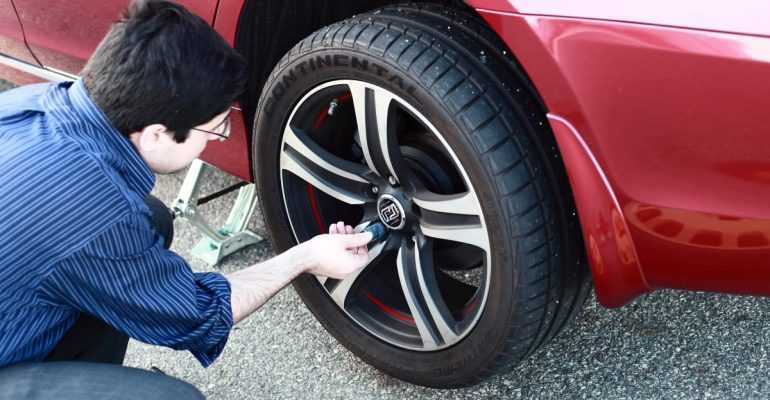
After determining the driving conditions, pay attention to the tread pattern: a high-quality winter tire should have a lot of rectangular blocks, small strips (sipes), due to which the winter tire holds the road better (as if clinging to the slightest bumps with the sipes).
Tire depth also matters. Although some experts advise buying wide wheels, but from many years of experience for city driving, I advise you to take narrow and high ones - according to the laws of physics, such a tire presses harder on the surface, and therefore its handling, braking distance and acceleration characteristics are much better. Due to bad roads, choose a tire with the deepest tread to increase ground clearance.
DIFFERENCE - IN THE FORMULA
Lamels are made of rubber
Absolutely all global concerns that produce tires produce cheap, medium-priced, and expensive models. At first glance, wheels of the same size differ slightly. However, the difference between expensive and cheap tires is enormous even if the tread pattern is similar (or copied).
It's all about the rubber compound. The fact is that a car tire is made of several dozen components: natural and synthetic rubber, soot, silica, all kinds of chemical additives, the content of which varies depending on the mixture formulation. The most expensive component - rubber - is quite expensive. Therefore, in cheap tires they try to use it to a minimum - to the touch such tires are oak, plastic, and have an irritating smell.
It's not always worth paying for studs
On the market, this kind of tires are sold under Chinese, Turkish brands, as well as from some factories in the CIS countries. Interestingly, for their level, the price for them is quite high - for one wheel of the 14th radius they ask about 500 UAH.
Note that tires of normal quality (produced under European and Japanese licenses at factories in Poland, Romania, the Czech Republic, Ukraine and Russia) are asked for about 100-200 UAH. more, and, judging by numerous tests, their quality is many times higher.
By the way, studded versions are a third more expensive than regular ones. But you should buy them only if you live outside the city.
WINTER TIRES DO NOT ALWAYS SAVE
Weather. During the winter, it can change driving conditions many times
Even if the car is changed into the most expensive tires, it is not worth driving just as famously as in summer. The fact is that there is no universal rubber for winter - each model is designed for certain operating conditions, and they can change radically several times during the season. For example, a driver bought tires for driving on ice and deep snow, and suddenly a thaw began on the street and he had to drive through slush. So every time you choose a safe speed, you need to take into account absolutely all the factors that can affect safety (the same is required by traffic rules).
3 CHANGING SHOES
Process. In good workshops, the wheels are tightened by hand. Photo by G. Salay
Photo by G. Salay
Despite the fact that today tire shops can be found on every corner, and there are still no queues of those who want to change summer tires to winter ones, we advise you to approach the choice of a workshop responsibly.
Do not wear shoes where you bought them. Most workshops not only provide service, but also sell tires. At first glance, it's convenient. I came for summer ones, bought them, they immediately changed them and even offered to leave the summer ones for storage until spring. However, my friends had several cases when the seller gave them crooked tires (the naked eye does not see such a defect), and the tire fitter “did not notice” this drawback and installed unbalanced wheels. The result is handling problems, noise. And it was possible to find out the cause of the problems only upon arrival at another tire service.
Look at the machines. It is impossible to balance on bad equipment, so take a close look at the tools of the masters. So, the balancing machine must be installed on a concrete pad and securely fixed - otherwise its readings are just numbers from the ceiling. And on the paws of the tire beading machine, there should be special plastic pads to avoid scratches on the disk. By the way, the master is obliged to wash the wheel before balancing, otherwise the dirt can lead to errors in the readings of the equipment - with large queues, the masters often forget about this in a hurry.
So, the balancing machine must be installed on a concrete pad and securely fixed - otherwise its readings are just numbers from the ceiling. And on the paws of the tire beading machine, there should be special plastic pads to avoid scratches on the disk. By the way, the master is obliged to wash the wheel before balancing, otherwise the dirt can lead to errors in the readings of the equipment - with large queues, the masters often forget about this in a hurry.
Caution, air gun. Craftsmen can unscrew and tighten nuts using pneumatics. But to tighten - only manually. Otherwise, you can make a mistake with the centering of the wheel, which will affect the chassis.
FOR ALL SEASON TIRES
Ukrainian car dealerships continue to sell so-called all-season tires (with All Seasons mark on the cord). For the consumer, the purchase of such wheels is quite attractive - in the spring there will be no need to change shoes again.
FROM EUROPE. You can buy such wheels, but only if you will not drive in severe frosts. The fact is that according to its characteristics, this is an ordinary summer tire intended for sale in countries where, in our understanding, there is no winter - 5 degrees below zero is considered a terrible cold (“gray” dealers import such wheels to Ukraine, buying them cheaply during the sales season ). According to the tests of a number of foreign publications, such wheels can easily withstand slush, but already during snowfall and on ice, their efficiency drops sharply.
The fact is that according to its characteristics, this is an ordinary summer tire intended for sale in countries where, in our understanding, there is no winter - 5 degrees below zero is considered a terrible cold (“gray” dealers import such wheels to Ukraine, buying them cheaply during the sales season ). According to the tests of a number of foreign publications, such wheels can easily withstand slush, but already during snowfall and on ice, their efficiency drops sharply.
There is also a range of all-weather tires designed for vans and light trucks. This technique does not go fast, and changing shoes is not economically feasible.
ON SHI TIRES. In our country, tires developed as all-weather tires are still sold in the Soviet Union - they are produced by enterprises in the CIS. Interestingly, they are in steady demand - they are bought by drivers of Zhiguli, Niv, Volg, Moskvich. But tragedies do not happen: usually such people either do not drive in winter, or drive only for short distances.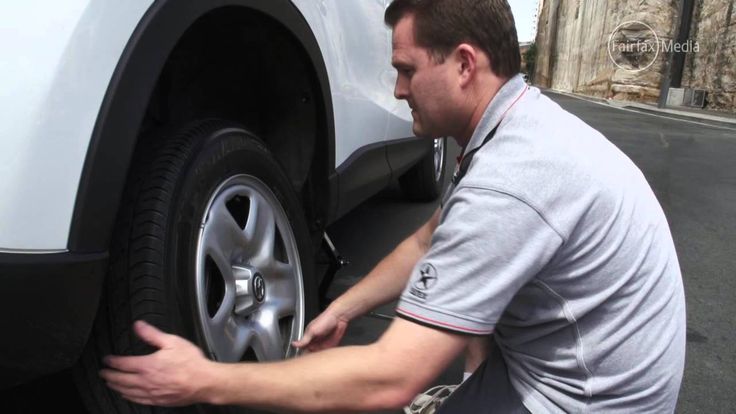
Vladislav Bovsunovsky
With the advent of spring, more and more owners of personal vehicles begin to think about the process of replacing tires on their car. Like ordinary shoes, car tires have features that allow you to use them at certain times of the year.
Using the wrong type will cost the owner of the car more money or may create a dangerous traffic situation.
The main difference between both tire options is the different technology used to create rubber shoes for the car. Winter tires feel great at low temperatures, but during hot weather it tends to soften. This feature can lead to loss of control over the car in the warm season, which means it will cause a dangerous situation on the roads, which can lead to human casualties. As the temperature rises, the life of the winter version of tires decreases markedly. This type of rubber breaks down quickly in warm weather, especially when the vehicle hits potholes or the vehicle runs over obstacles.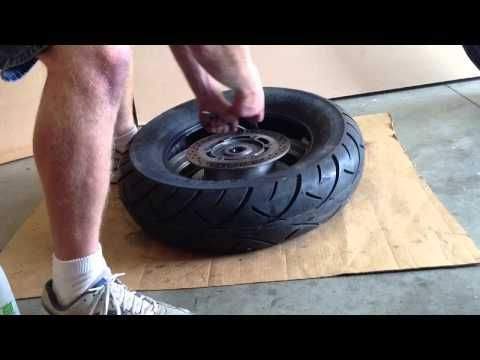
Summer tires for a car have completely opposite properties - at low temperatures, the surface of the tire becomes very hard, which leads to poor grip on the road surface. Even on a clean road, such rubber behaves very badly with a noticeable cold snap. The movement of a car on a summer version of tires on an icy track very often leads to disastrous consequences, which may be accompanied by human casualties or large financial waste associated with serious vehicle repairs.
Each vehicle owner replaces winter tires with their summer version, according to their personal convictions. There is no specific time when this procedure should be carried out, so every motorist can replace car tires at any time convenient for him. It is recommended to replace winter tires with summer tires when the night air temperature will have a constant positive value. Changing tires too early can result in the vehicle being driven during the traditional morning frost, which is not conducive to good vehicle control.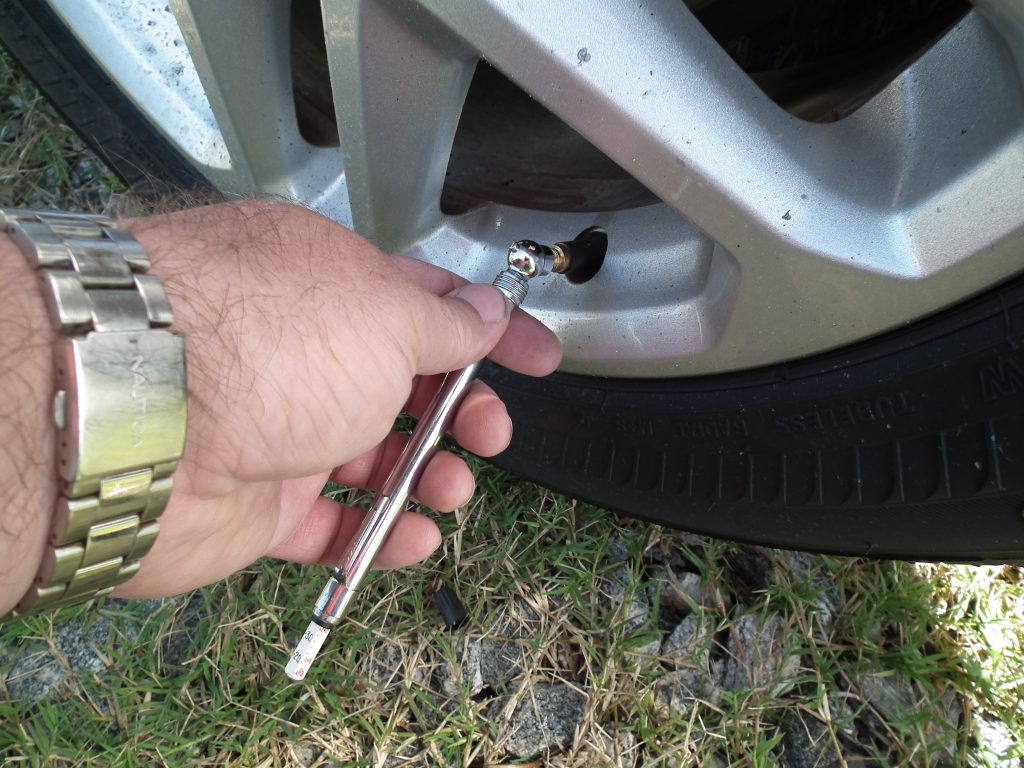
Replacing car tires is a fairly simple process - at a service station, this procedure takes no more than half an hour of free time, and such a process is not expensive enough. However, many car owners prefer to replace winter tires with summer tires on their own. Of course, you can install demi-season tires on your vehicle, but this option has several significant drawbacks. First of all, this is the price, which is much higher than that of conventional analogues. The second drawback is that this version of tires does not have the full positive qualities of winter and summer tires. That is, a demi-season tire in winter and summer has lower technical characteristics than traditional rubber options for various weather conditions.
If the car owner has the opportunity to completely change the wheels of his vehicle, then changing shoes will not require much effort and waste of personal time. To carry out all work, you need to have at your disposal a tubular wrench of a suitable size and a car jack.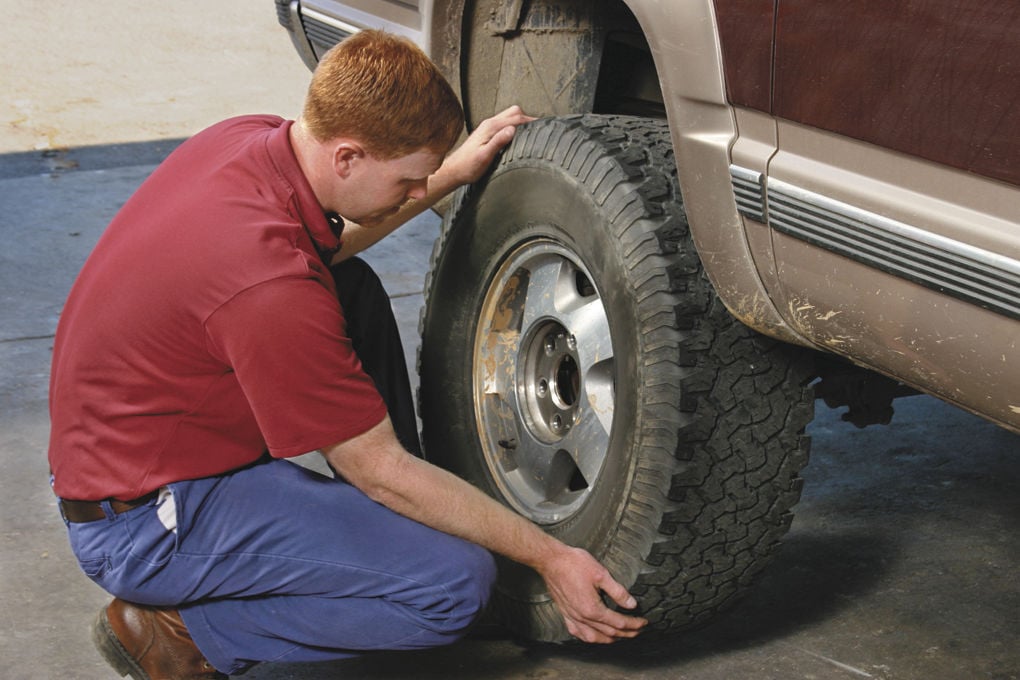 The nuts on the wheels of the car are unscrewed until the body of the vehicle is raised, then the vehicle is raised to the required height and the process of replacing car shoes is carried out. The wheels should be fixed in a cruciform way, which is done again with a full load on the new element of the car.
The nuts on the wheels of the car are unscrewed until the body of the vehicle is raised, then the vehicle is raised to the required height and the process of replacing car shoes is carried out. The wheels should be fixed in a cruciform way, which is done again with a full load on the new element of the car.
Even with such a simple process, all safety measures must be observed: the car must stand on a flat and solid surface, be set to the handbrake, and additionally secured with shoes. If it was not possible to find a sufficiently hard ground, a sufficiently wide board should be placed under the jack support to reduce the pressure force produced by the car.
Some vehicle owners do not use additional complete wheels in their everyday life - in such cases it is necessary to carry out tire fitting. This process is also not a particularly difficult procedure, although most people try to perform it in service organizations. For those who do not know how to board the wheel on their own, we will give a description of this process.
This procedure requires two special mounting spatulas. The wheel rim is pre-lubricated with an ordinary soapy solution, then, using the wide ends of the blades, the tire is torn off the seat. To do this, it will require a certain physical effort to squeeze the rubber material from the metal base. Tire replacement occurs in reverse order using the same tool, moving it along the perimeter of the car wheel.
Rubber, like ordinary shoes, has a large number of different types, which have their own characteristics and technical characteristics. An analogy would be appropriate here: a person wears sneakers primarily for sports or personal convenience, while shoes are more designed to create an image and wear them at ceremonial receptions or going to work. Likewise, different types of car tires are designed for different uses.
Summer car tires are road or high-speed. If the first option fits the standard driving process, then high-speed tires are installed on sports vehicles or by lovers of high-speed road travel.
There are three types of tread patterns on car tires:
This variant copes well with driving in bad weather conditions in summer, for example when driving on wet roads. The disadvantage of this tire option is the short service life of the product and the impossibility of installing it on the opposite side of the vehicle;
2. Symmetrical tread pattern.
The advantage of this type is a long service life and good technical characteristics of the product;
3. Asymmetrical tread pattern.
Has the main positive features of the first two types of car tire tread pattern.
For short distance urban driving, the second type of tire is ideal. Car owners who make long trips on trails usually use a directional tread pattern as the most suitable for this process. For lovers of fast driving, the ideal option is to purchase the third type of car tires, as it is most suitable for this type of vehicle driving.
Extreme driving enthusiasts should purchase wide profile tires as they are better able to cope with dangerous situations on the road and have a long service life. If you like a leisurely ride and are used to saving your money, then narrow-profile tires are your ideal choice.
If you like a leisurely ride and are used to saving your money, then narrow-profile tires are your ideal choice.
When choosing between standard and low-profile tires, it should be taken into account that the second option shows good vehicle stability, while significantly reducing the comfortable state of the vehicle when driving. In addition, this version of summer tires is much more expensive than traditional tires and has a much shorter service life.
In the end, I would like to note one important factor when choosing summer tires - you should carefully read the markings on the tire and know the technical characteristics of your vehicle. Different rubber options have different speed limits and the possible load on each wheel of the car. A very important element when choosing rubber are the load and speed indexes, which are located on the surface of the tire in one place. For example, the designation "90T" means that the maximum load on one wheel of the car should not exceed 600 kg, and the speed limit is limited to 190 km / h.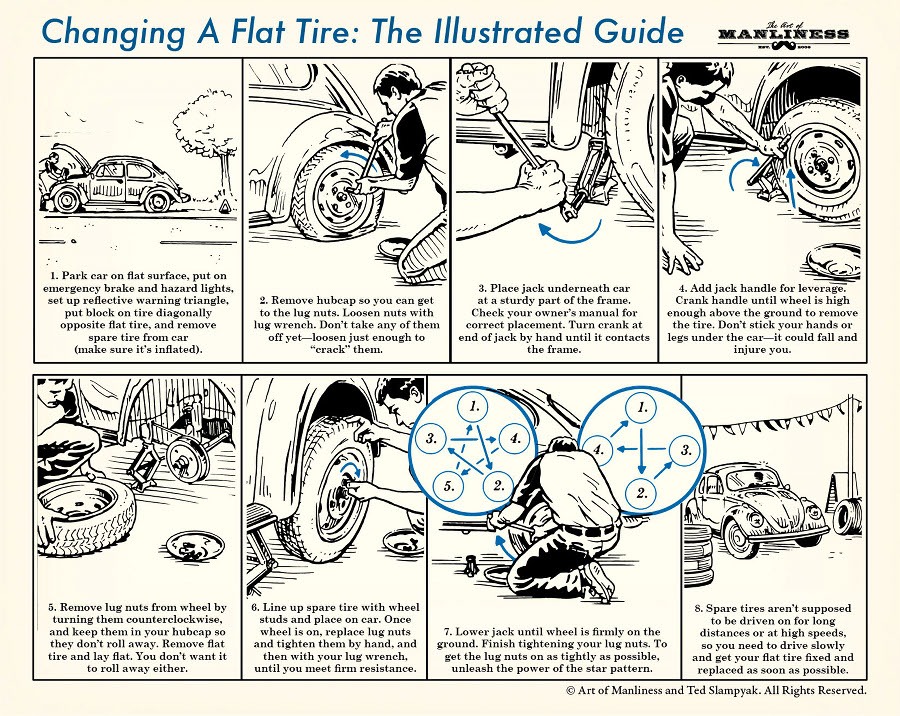
http://avtofactovic.ru/zamenit-rezinu/ — link
A couple of years ago, when I had a crappy jack, I personally changed the wheel on the car only in cases of emergency.
The jack had a handle that had to be turned for a long time first in one direction to raise the car, and then in the other to lower it.
To replace winter tires with summer tires, I drove the car to a tire shop, fortunately, they charge godly money for this service.
Well, at one fine moment I decided that I could no longer live without a rolling jack.
Immediately after the purchase, it turned out that there was a low oil level in the jack cylinder. I had to add a spindle or something like that to it, and it still worked.
Getting back to changing tires, it's now considered normal to have two sets of wheels, one with winter studded tires and one with summer tires.
Why do you need winter and summer tires?
The tread of summer tires is less deep, and the tire itself is harder than winter tires; speed for optimal fuel consumption.
And in winter, especially on ice, the friction between the rubber and the road is not enough, and tricks such as deep tread, soft rubber and metal spikes are needed for normal driving.
When I was a child, people either didn't have studded tires at all, or had to bead their wheels twice a season, and most didn't have cars and walked. Or maybe I have wrong memories from childhood about this side of the life of motorists?
Coming back to changing tires, now for the last time: now I change the wheels myself. This is easy to do, especially with a good jack, a good key and a VW Passat B3.
I start by laying out my essentials next to the car and putting on cleaning gloves. Then I remove the decorative cap from the wheel and use the key to loosen all four bolts securing the wheel.
It is still impossible to unscrew them completely, even if you really want to.
The good thing about the Volkswagen Passat is that the bolts come out easily and quickly, you only have to apply force to move the bolt from its place, and then you can twist it with your fingers.
After the bolts are loosened, the vehicle must be jacked up.
Rolling hydraulic jack for this purpose is the most convenient, in my opinion.
When the wheel is already free in the air, I finally unscrew the bolts and remove it.
Summer tires can be stored from now on.
I replace the wheel with the winter tire and screw it on.
Then I lower the jack and put a decorative branded cap on the wheel.
Similarly, I change three more wheels. After replacing them, the car is ready for operation on a winter road. On the way to the city, you will need to drop into a tire shop and check the pressure in the tires.
Get ready for your tire fitting trip: what you need to know and follow to save time, money and…health?
I decided to write about tire fitting after two stories.
First : I flew away on a business trip in autumn, and it snowed the day before.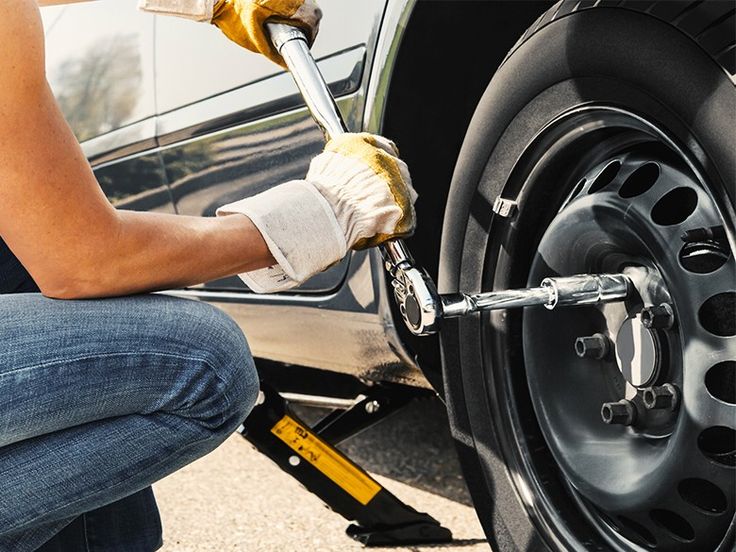 For the safety of trips, the wife decided to change the car. In the nearest tire shops there were huge queues.
For the safety of trips, the wife decided to change the car. In the nearest tire shops there were huge queues.
Cars were moving slowly. An hour has passed. Another.
At the beginning of the third it was my turn, the sleepy and tired guys quickly changed the winter tires to rims, and I drove home. After the second intersection, I realized that the vibration increases with increasing speed. And that the fallen snow could not turn into ice gouges so quickly. Why is the car shaking so much?
Second story: mother told how she was driving home from work in the evening in heavy rain. At the intersection, turning right, the back of the car pulled to the side. She was frightened, she said, grabbed the steering wheel. It seems that the speed was low, there were no large puddles.
The skid turned out to be small, turned normally. She drove on slowly, her heart pounding. Should I have gone even slower?
Now I will tell you four rules that will help you avoid such situations on the roads and save time and money.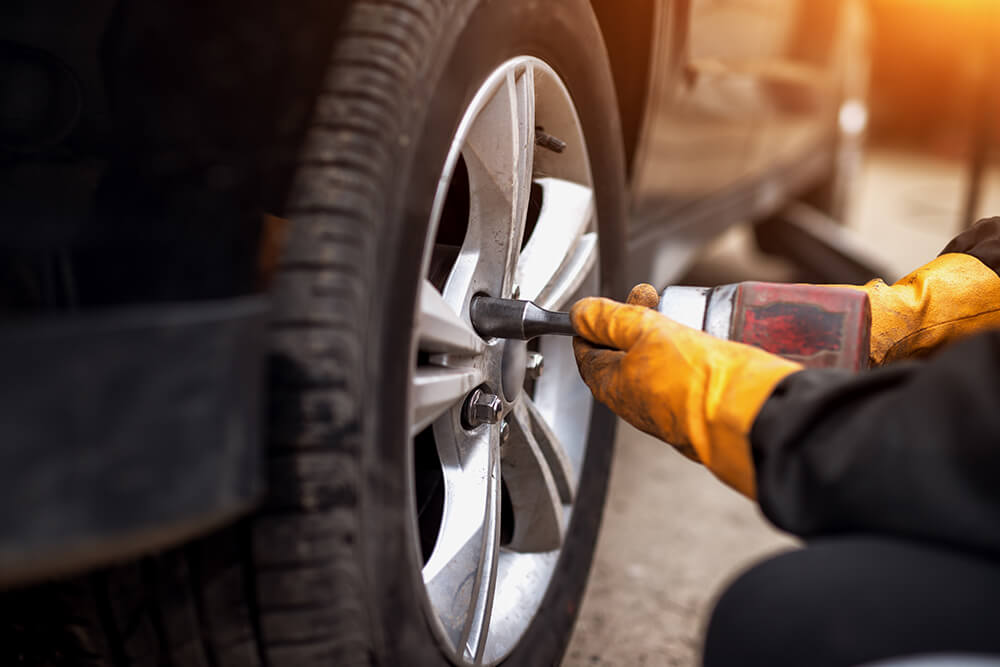
The pressure depends on how much load you ride. For one driver and for a car with five passengers, it will be different. Sometimes the pressure for the front and rear tires is different.
Provide the correct required pressure to the tire service and ask them to inflate the tires in this way.
Why is this important? Safety and economy. When setting up security systems, the manufacturer focuses on this tire pressure. Efficiency is ensured by an optimal balance of "fuel consumption-comfort".
Ask tire workers to inspect and check tires. They can find defects invisible to the normal eye.
For example, lateral hernias, cuts, heavy wear.
Why is this important? The sooner you know about such problems, the safer the road will be. Tire fitters have a trained eye, be sure to use their experience to your advantage.
After installing the tires on the machine, be sure to check that they have been installed correctly.
Some tires have a different outer and inner side. In this case, “ Outside” will be written on the outer sidewall. " and "Inside" on the inside. Make sure the outside is outside.
Sometimes it is indicated on the sidewall in which direction this tire should spin. Then they will write “ Rotation " and the arrows show how the tire should roll when moving forward.
Asymmetric and directional patterns are now found on most road tires, so be sure to install them correctly.
Check that all wheel bolts were in place . And that they cannot be turned by hand.
Why is this important? Tire manufacturers with asymmetry and directionality of the pattern solve problems that are not subject to the chemical composition of the rubber compound. Tires are tested exclusively with the correct installation. By neglecting this, you degrade the performance of the tires. Baited or missing bolts (or studs) fix the wheel worse.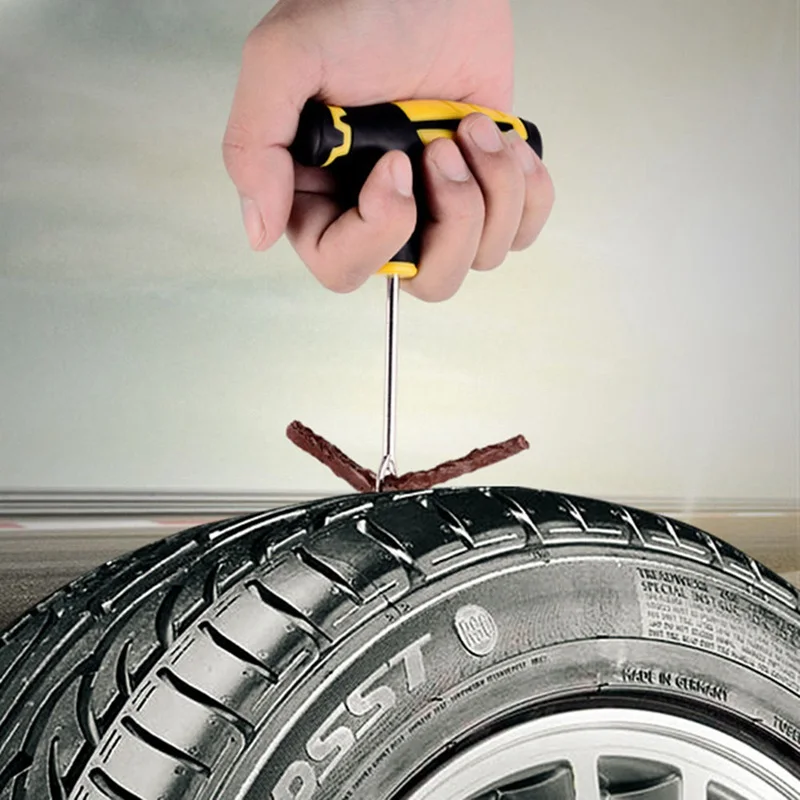
Immediately after changing your shoes, turn off the music in the car and listen to the sounds and sensations. If road conditions allow, try to smoothly accelerate and brake, perform a snake or a rearrangement.
Possible bad symptoms:
As a bonus - desirable but optional tire fitting rules. They will also help you understand the level of service you have arrived at.
A good mechanic will clean the tires and rims with a wire brush. Or even wash the wheels. Clean tires are more pleasant to work with, easier to inspect, and better balanced.
Even in a good tire shop you will be lubricated or at least offered to lubricate the inner edges of the tires. Lubrication will help the tire to sit in place faster, and at the end of the season - to simplify dismantling.
Clean bags can be a nice bonus, in which you will not stain the car when transporting tires.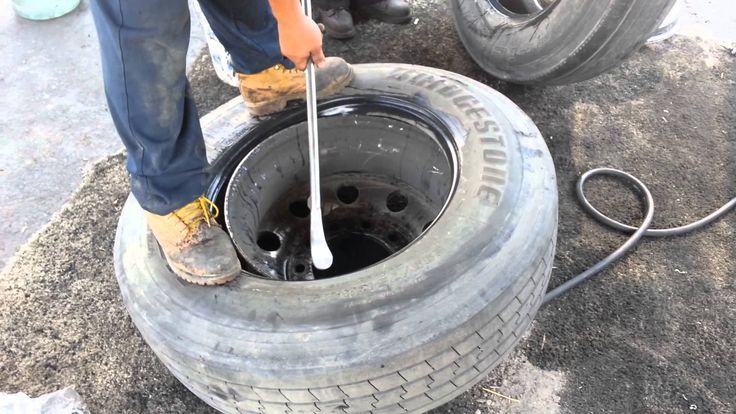
What about our stories? After the vibration, I returned to the tire shop. Waited for the master to be free. Then I said where the vibration was coming from. The tire fitter removed the wheel and found that the adjusting ring was crooked, causing the wheel to be set at an angle.
Later, on my mother's car, I saw "Inside" written on the rear wheel. So we went and set it right.
Next time at the tire shop, remember these rules:0319
An integral part of any road transport are tires, without which it is impossible to imagine normal and safe driving. Therefore, it is very important to replace the summer version with the winter one in time and vice versa in order to ensure the safest possible ride in all weather conditions and road surfaces. Next, we’ll talk in more detail about in what cases and how you can change tires for the winter version yourself.
Next, we’ll talk in more detail about in what cases and how you can change tires for the winter version yourself.
- Tire damage or puncture is a common cause when there is a need for a car owner to replace car tires. At the same time, it is not recommended to continue driving with a damaged tire. This can lead to an accident on the road. In the event of a tire puncture, you can call a tow truck, mobile tire service or try to change the tire yourself. To do this, you need to have a backup option, as well as all the necessary tools. In the absence of certain knowledge and skill, it is recommended to use the services of an on-site tire fitting. This will guarantee safe driving.
Also related: What to do if you had to drink while driving?
- Significant tread wear is another common cause when a tire needs to be replaced. 1.6 mm is the maximum allowable minimum, which cannot be exceeded. Otherwise, the tire will not be able to provide the desired level of grip on the road surface.
- Load, temperature conditions, storage conditions and driving style directly affect the condition of any tires. To avoid unexpected punctures and cracks, it is recommended to constantly review the tires in order to detect possible damage in the future in time.
- It is also worth remembering that the installation of various types of tires affects the directional stability of the car. Therefore, it is recommended to trust only specialists in the selection of tires for your vehicle.
— In addition, seasonal tire changes are mandatory to ensure reliable traction in all weather conditions.
Also related: Which fuel card to choose?
To change tires the price in Moscow is the lowest in the Prokol mobile tire service.
- First stage.
With certain knowledge and skills, the process of changing a tire is not as difficult as it seems at first glance. To do this, you need to place the disc on the surface prepared and covered with an unnecessary cloth with the reverse side. The rubber and disc should be wetted with soapy water to facilitate the process of pulling a new tire. In this case, it is not recommended to use oil, a soap solution will be enough.
The rubber and disc should be wetted with soapy water to facilitate the process of pulling a new tire. In this case, it is not recommended to use oil, a soap solution will be enough.
- The second stage.
We put the tire on top of the lubricated disc, and evenly pressing on its surface, we try to pull it onto the disc. In this case, only part of the tire will go onto the disk, so you will also need to use a hammer and pry bar. In this case, you must be very careful not to damage the surface of the tire.
Also related: How to choose an electric motor for a boat?
- The third stage.
Approximately no more than two hours will be required to change the tire. In this case, it is necessary to ensure the tightness of the connection so that air does not get between the border and the rim of the tire.
To fix this problem, do the following:
- Use a tire instead of a compressor by inflating it with twice the normal pressure. This is only possible if a spare wheel is available.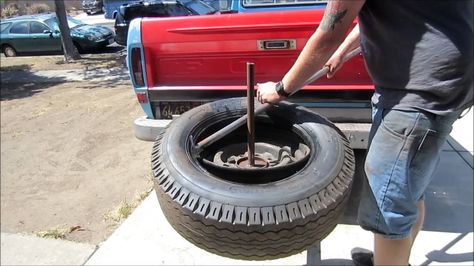 Otherwise, you need to look for alternative methods.
Otherwise, you need to look for alternative methods.
- We set fire to the fuel in the middle of the tire. The tire will inflate under the influence of vapors. This will allow you to correctly pull it onto the disk.
Car tires play an important role in vehicle operation. They provide comfort while driving, make the movement in the car safe, provide reliable traction in adverse weather conditions. And the first thing to remember for both a novice and an experienced motorist is the need to control the level of tire pressure.
Why is this important? It is the pressure indicators that determine the readiness of the wheel for road confrontation in all weather conditions. Thus, a decrease in tire pressure leads to an increase in fuel consumption. And in a critical situation, it can cause loss of controllability and stability of the vehicle. So is it worth the risk if regular tire pressure checks will help you avoid a lot of the hassles associated with the operation of the car?
Before you learn the tricks of tire fitting with your own hands - in a garage or outdoors, it is important to study the theoretical part of the process. To begin with, it is worth deciding on the complete set of an automobile wheel, consisting of a tire and a disk with a rim on which it is put on.
To begin with, it is worth deciding on the complete set of an automobile wheel, consisting of a tire and a disk with a rim on which it is put on.
All types of modern car tires are divided into several categories with their own design features:
In addition, tires are divided into:
Car tires are graded according to the type of arrangement of threads in the cord base. It can be radial - at a right angle relative to the sides, or diagonal, with threads crossing from sidewall to sidewall diagonally.
It can be radial - at a right angle relative to the sides, or diagonal, with threads crossing from sidewall to sidewall diagonally.
The ability to remove and install a car wheel is a great advantage for a car owner. You can be calm in the most non-standard traffic situation, and in the conditions of an urgent seasonal tire change. And if you have not yet mastered all the wisdom of automaking, it is never too late to take the first steps in the right direction. The main thing is to learn the procedure.
To remove/install a car wheel, you will need:
After completing the preparations, proceed in stages:
 The car is put into first gear. To securely fix the vehicle, it makes sense to use special devices ("shoes").
The car is put into first gear. To securely fix the vehicle, it makes sense to use special devices ("shoes"). A removed wheel must be replaced with a spare. To do this, a pre-prepared "reserve" is placed in the place of "landing" of the wheel, installing it with the help of studs or guides - depending on the design. And then they are fixed (not completely) with the help of previously dismantled fasteners, checking the reliability of fixation (the nuts must be screwed in order of priority, starting from the topmost, in a diagonal sequence - this ensures proper centering).
The final tightening of the nuts is done only after the vehicle has been lowered from the jack. Upon completion of the installation procedure, it is necessary to check the tire pressure (normally it should be from 2 Bar or more) and, if necessary, bring its indicators to the desired values.
Sometimes a tire fitting procedure requires more than just a temporary fix by replacing a wheel, but much more decisive action. In particular, replacing a tire on a car disk, which even in a garage does not look like a simple matter. What does it take to change tires yourself?
Do-it-yourself wheel beading is a process that requires a certain endurance. It is necessary to separate the tire from the rim as carefully as possible, gradually pressing the rim. With paddles between the rim and tire, use the soapy solution as a kind of lubricant, making it easier to release the tire bead from under the rim.